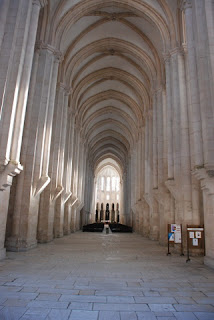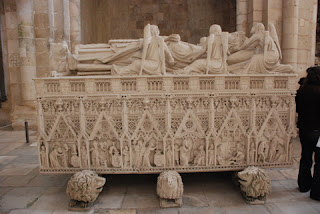





 Not far from Batalha is another beautiful abbey, or rather a monastery – Alcobaca – and this was our destination today. The monastery was founded by Dom Henrique to celebrate his victory over the Moors at Santarem in1147 and became immensely rich due to the huge amounts of land with vinyards and orchards. It also held jurisdiction over a dozen towns and three ports.
Not far from Batalha is another beautiful abbey, or rather a monastery – Alcobaca – and this was our destination today. The monastery was founded by Dom Henrique to celebrate his victory over the Moors at Santarem in1147 and became immensely rich due to the huge amounts of land with vinyards and orchards. It also held jurisdiction over a dozen towns and three ports.The romantic figures of Dom Pedro and Dona Ines de Castro are buried in the church of Alcobaca. Dom Pedro was deeply in love with Ines de Castro but Alfonso IV, Dom Pedro's father, forbade the marriage because Ines was the daughter of a Galician (Spanish) nobleman and there was great concern over Spanish influence on the Portuguese throne. They were secretly married in a remote town and Alfonso came under great pressure to have his daughter-in-law murdered, to which he eventually agreed. We can only imagine the effect that this had on Dom Pedro and when he succeeded his father to the throne in 1357 he personally ripped the hearts out of the murderers. He then exhumed the body of Ines, crowned her and forced the entire royal entourage to acknowledge her as queen by kissing her decomposing hand. More gruesome than romantic I would say. Their beautifully carved stone tombs are on opposite sides of the church in front of the alter and are inscribed “Ate ao Fim do Mundo” (Until the End of the World). On Dom Pedro's instruction, the tombs have been placed foot to foot so that on the Day of Judgement they will rise and feast their eyes on each other. I can class that as romantic.
The wealth of the monastery lead to the monks becoming far too worldly and at the turn of the nineteenth century the Englishman William Beckford commented that he became tired of the “perpetual gormandising” and he described the “fat waddling monks”. Unsurprisingly, the kitchen is extremely impressive and even has a diverted river flowing through it that delivered fish directly into a basin. Goldfish swim now in the basin, although I suspect that these don't come from the river! Beckford also informs us that the monks had a Chinese lay brother chef who cooked birds' nests and sharks' fin. I particularly liked his comment that the brothers had to file through a narrow door on the way to the refectory. If they could not fit through, they had to fast until they were slim enough.
We had spare time before we needed to get to our campsite in Peniche (just down the coast from Nazare), so we called in at the town of Obidos and were very glad that we did. Approaching the town was very impressive, a small but perfectly formed medieval walled town on the top of a hill. We parked in the car park next to the 3 km long aqueduct built on the orders of Queen Catherine of Austria in the sixteenth century.
For the third day running, it was a beautiful day and we decided to walk around the top of the walls. Although the views in the distance were quite hazy, the view of the town was really interesting and a good precursor to walking around the town. We had to come off the walls briefly at the top of the hill to go round the Old Arms Square and the castle, now a very impressive (and no doubt very expensive) poussada (hotel). In the square they were taking down the extensive Christmas Fair stands and putting up new stands for the forthcoming International Chocolate Festival. When we went into the tourists office in the town we found that it was run by an English couple and they told us that there had been over 200,000 visitors to the Christmas Fair and they had to close one lane of the nearby motorway and use it as a car park in order to accommodate the visitors. They also told us about the Chocolate Festival, which was started five years ago. The first one was sponsored by Cadbury and they totally underestimated the number of visitors. They ran out of chocolate, and the restaurants ran out of food and drink. It was so busy that, for the first time since Medieval times, they had to close the town gates as the town was full. The finals of the international chocolate competition (including life-size chocolate figures such as Batman and Robin) are held here. This has all been the work of a young go-ahead mayor who has put this small town on the international map.
Obidos up to the fifteenth century used to be on the coast with boats moored at the base of the hill. This is rather difficult to believe when we drove for forty minutes to the coast! Peniche, an island until the sea receded, sounded really nice in the guide book but our first impressions were not encouraging. The sand dunes looked good but there was a great deal of not very attractive development and a number of factories. It is a large working port, so this is understandable. The campsite was also a little disappointing and we were the only guests.
Photos: Interior of Alcobaca church; Ines de Castro tomb; Dom Pedro tomb; Alcobaca kitchen; Alcobaca refectory – sacred texts were read from the pulpit during meals; View of Obidos from outside the walls; Obidos castle from the walls.
No comments:
Post a Comment